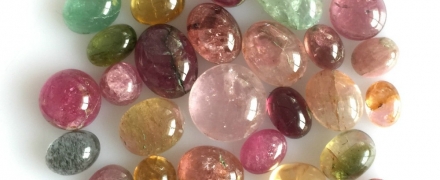open 10 am - 7 pm
laboratory is closed
Cabochon Cut

Cabochon is a type of cut in which a faceted stone takes on a rounded convex shape with a smooth polished surface.
This type of cut appeared a long time ago, according to various sources in the 15-16 century. Initially, the craftsmen simply smoothed the corners of the mineral and only later began to give the stones a rounded shape.
The cabochon cut stone is usually convex on one side and flat on the other. However, sometimes there are other varieties of cabochons - mutually convex, concave and even hollow. The shape of cabochon stones can be varied, most often it is a circle and an oval, but you can also find them in the form of drops and hearts.
For the manufacture of cabochons, stones are usually used that have any optical effects or a saturated color, but which are not characterized by a good gloss when faceted due to a low refractive index or the presence of significant internal defects. The most common minerals in the form of cabochons are star ruby and sapphire, opal, “moonstone” (aka oligoclase), hair quartz, “cat's eye” (aka cymofan, a type of chrysoberyl) and others.
Also, with the help of cut cabochon often emphasize the beauty of the structures of minerals. Therefore, we often find malachite, chrysocolla, charoite, lapis lazuli and similar stones cut in a similar way.
В геммологической практике бывают весьма увлекательные случаи с диагностикой ювелирных вставок
Но помимо редкости цвета и высокой стоимости таких камней, многие розовые камни выделяются одной замечательной особенностью – они проявляют плеохроизм, то есть в зависимости от положения осмотра камня он может иметь дополнительные оттенки – оранжевый или пурпурный.
Currently, gemstones are produced by two fundamentally different technological methods - the High Pressure - High Temperature method (“HPHT”, High-pressure & High-temperature) and the Chemical Vapor Deposition (“CVD”, Chemical vapor deposition) method. The "HPHT" method is the most tested classical synthesis method, which can be used both carbon deposition on diamond from flux melts and catalytic reactions. In "CVD" synthesis, diamond growth occurs on a seed during carbon deposition mainly from a gaseous medium at relatively low temperatures and pressures.
Jewelry and precious stones are just such a category of goods, when buying which you need to pay attention to many criteria.
Sogdianite is a rather rare mineral and more often it can be found as a collection material (moreover, in systematic collections), and it is extremely rare in jewelry.






